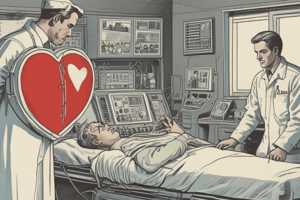Podcast
Questions and Answers
What are the four factors regulating the circulation of fluid between capillaries and interstitial tissue?
What are the four factors regulating the circulation of fluid between capillaries and interstitial tissue?
What factors predispose to thrombus formation in leg veins?
What factors predispose to thrombus formation in leg veins?
What are the major complications of venous thrombi?
What are the major complications of venous thrombi?
What factors lead to shock?
What factors lead to shock?
Signup and view all the answers
What are the current concepts regarding risk factors for coronary heart disease?
What are the current concepts regarding risk factors for coronary heart disease?
Signup and view all the answers
Which of the following is a risk factor for cardiovascular disease?
Which of the following is a risk factor for cardiovascular disease?
Signup and view all the answers
What is the major cause of aneurysms?
What is the major cause of aneurysms?
Signup and view all the answers
Which test is involved in the diagnosis of coronary artery disease?
Which test is involved in the diagnosis of coronary artery disease?
Signup and view all the answers
What is the primary cause of isolated systolic hypertension?
What is the primary cause of isolated systolic hypertension?
Signup and view all the answers
Which type of hypertension accounts for 95% of cases?
Which type of hypertension accounts for 95% of cases?
Signup and view all the answers
What are arterioles primarily composed of for controlling blood flow to capillaries?
What are arterioles primarily composed of for controlling blood flow to capillaries?
Signup and view all the answers
What is the primary function of capillaries in the vascular system?
What is the primary function of capillaries in the vascular system?
Signup and view all the answers
What are the main factors regulating fluid flow in the circulatory system?
What are the main factors regulating fluid flow in the circulatory system?
Signup and view all the answers
What can arterial thrombi lead to as a consequence of atherosclerosis?
What can arterial thrombi lead to as a consequence of atherosclerosis?
Signup and view all the answers
What is a common presentation of venous thrombosis and its associated risk?
What is a common presentation of venous thrombosis and its associated risk?
Signup and view all the answers
What is the most important test for diagnosing pulmonary embolism?
What is the most important test for diagnosing pulmonary embolism?
Signup and view all the answers
Which circulatory disturbance can occur following severe bone fractures and lead to obstruction of pulmonary capillaries and small vessels in the brain and other organs?
Which circulatory disturbance can occur following severe bone fractures and lead to obstruction of pulmonary capillaries and small vessels in the brain and other organs?
Signup and view all the answers
What can cause edema due to the disturbance of extracellular fluid circulation between capillaries and interstitial tissues?
What can cause edema due to the disturbance of extracellular fluid circulation between capillaries and interstitial tissues?
Signup and view all the answers
What can lead to circulatory failure and occur accidentally through injection or due to a chest wound?
What can lead to circulatory failure and occur accidentally through injection or due to a chest wound?
Signup and view all the answers
What can cause temporary reduction in output from the left ventricle and rapid engorgement of the lungs with blood, leading to impaired oxygenation and shortness of breath?
What can cause temporary reduction in output from the left ventricle and rapid engorgement of the lungs with blood, leading to impaired oxygenation and shortness of breath?
Signup and view all the answers
What is the primary cause of arterial thrombosis according to the text?
What is the primary cause of arterial thrombosis according to the text?
Signup and view all the answers
Which condition can occur in patients with cancer due to increased platelets and coagulation factors?
Which condition can occur in patients with cancer due to increased platelets and coagulation factors?
Signup and view all the answers
What is the characteristic of atherosclerosis mentioned in the text?
What is the characteristic of atherosclerosis mentioned in the text?
Signup and view all the answers
What can lead to the permanent narrowing of vessels in advanced atherosclerosis?
What can lead to the permanent narrowing of vessels in advanced atherosclerosis?
Signup and view all the answers
What role do genetic factors play in atherosclerosis according to the text?
What role do genetic factors play in atherosclerosis according to the text?
Signup and view all the answers
Study Notes
Cardiovascular Disorders and Thrombosis
- Circulatory disturbances can lead to hypovolemic shock, cardiogenic shock, septic shock, and anaphylactic shock due to various pathogenic factors.
- Shock occurs when blood flow or pressure is too low to supply the body adequately, potentially becoming life-threatening.
- Arterial thrombosis is primarily caused by vessel wall injury from arteriosclerosis, leading to infarcts in various arteries, such as coronary, leg, and cerebral arteries.
- Intracardiac thrombosis may dislodge into systemic circulation, causing infarction in major organs like the spleen, kidneys, brain, and lungs.
- Thrombosis can occur within the atria, on damaged heart valves, and on the wall of the left ventricle, often due to increased coagulability from factors like polycythemia, contraceptive pills, and hereditary gene mutations.
- Patients with cancer are predisposed to arterial and venous thromboses due to the rapid release of thromboplastic materials into circulation from tumors, causing hypercoagulability.
- Disseminated Intravascular Coagulation (DIC) can occur in patients with cancer due to increased platelets and coagulation factors.
- Arteriosclerosis is a chronic and progressive degenerative disease of large to mid-sized arteries, leading to the accumulation of inflammatory and immune cells, cholesterol, and lipids, resulting in atheroma formation.
- Atherosclerosis is characterized by the narrowing of arteries due to lipid deposits from the bloodstream, leading to the formation of atheromatous plaques surrounded by fibrous tissue.
- Atheromatous deposits in advanced atherosclerosis can lead to permanent narrowing of vessels and are associated with risk factors such as elevated blood lipids, high blood pressure, smoking, and diabetes.
- Stable plaques and ulcerated plaques covered by thrombus material are examples of atheromatous deposits that contribute to the narrowing of arteries and potential complications.
- Genetic factors play a significant role in atherosclerosis, with an impact of 40-60%, making it a non-modifiable risk factor.
Studying That Suits You
Use AI to generate personalized quizzes and flashcards to suit your learning preferences.
Related Documents
Description
Test your knowledge of cardiovascular disorders and thrombosis with this quiz. Explore the causes and consequences of conditions such as shock, arterial and intracardiac thrombosis, arteriosclerosis, and atherosclerosis. Learn about risk factors, complications, and genetic influences on these cardiovascular issues.





